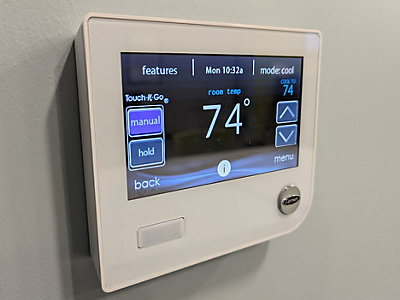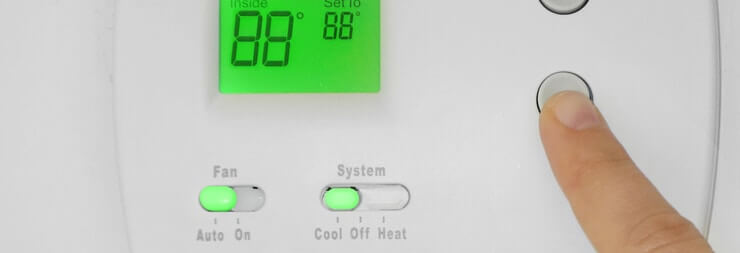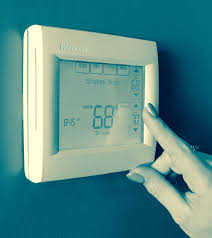The fan setting on a thermostat controls your HVAC fan. It can be set to “On” or “Auto.”
Understanding the fan setting on your thermostat helps manage your home’s comfort and energy efficiency. The “On” setting keeps the fan running continuously, circulating air even when heating or cooling is off. This can help with consistent air quality and temperature.
The “Auto” setting activates the fan only when heating or cooling is running, which can save energy. Knowing how to use these settings can make a big difference in your home’s comfort and your energy bills. Let’s explore the details and benefits of each fan setting to help you make the best choice for your home.

Credit: buckeyeheat.com
How Thermostats Work
Thermostats are essential for maintaining the desired temperature in your home. They help control heating and cooling systems. Understanding how thermostats work can save energy and money.
Basic Components
Thermostats have a few basic components. The first is the sensor. It measures the current room temperature. Another key part is the control unit. It compares the room temperature to the set temperature. Lastly, there’s the relay. It sends signals to the heating or cooling system.
Temperature Regulation
Temperature regulation is the primary function of a thermostat. The thermostat senses the room temperature. It then compares it to the desired setting. If the room is too hot or cold, the thermostat activates the heating or cooling system. This process continues until the room reaches the set temperature.
Some thermostats have advanced features. These include programmable settings and remote control. These features allow for more precise temperature regulation. They also offer convenience and energy savings.

Credit: colmanair.com
Types Of Fan Settings
Understanding the different fan settings on your thermostat can help you manage your home’s temperature more efficiently. By choosing the right setting, you can optimize comfort and energy use. Let’s explore the main types of fan settings available on most thermostats.
Auto Mode
In Auto Mode, the fan runs only when the heating or cooling system is on. This setting helps save energy because the fan does not run continuously. It’s ideal for maintaining a consistent temperature without wasting electricity. Auto Mode is a popular choice for many homeowners.
On Mode
On Mode keeps the fan running all the time. This setting helps circulate air continuously, providing a more even temperature throughout your home. It’s useful for homes with air quality concerns or allergies. However, it uses more energy than Auto Mode, leading to higher electricity bills.
Circulate Mode
In Circulate Mode, the fan runs at intervals, regardless of whether the system is heating or cooling. This setting offers a balance between energy efficiency and air circulation. It helps to maintain a comfortable environment by reducing temperature swings. Circulate Mode is a good option if you want to improve air quality without a high energy cost.
| Fan Setting | Function | Energy Usage |
|---|---|---|
| Auto Mode | Fan runs with heating/cooling | Low |
| On Mode | Fan runs continuously | High |
| Circulate Mode | Fan runs at intervals | Moderate |
Choosing the right fan setting depends on your needs. Consider energy efficiency, comfort, and air quality when making your decision. Each setting offers unique benefits, so select the one that best suits your home.
Benefits Of Fan Settings
Understanding the benefits of fan settings on a thermostat can help you make the most of your HVAC system. These settings can enhance your home’s comfort, improve air quality, and save energy. Let’s explore some key advantages.
Energy Efficiency
Using the fan setting can significantly boost your home’s energy efficiency. By circulating air, your HVAC system doesn’t need to work as hard. This can lead to lower energy bills. Here’s how it works:
- Distributes air evenly throughout the house.
- Reduces the need for constant heating or cooling.
- Maintains a stable temperature with less effort.
Energy savings can add up over time. This makes the fan setting a smart choice.
Improved Air Quality
Another benefit of the fan setting is improved air quality. By keeping air moving, it helps to filter out dust, allergens, and pollutants. This creates a healthier living environment. Key points include:
- Continuous air circulation helps remove airborne particles.
- Enhances the effectiveness of air filters.
- Reduces the build-up of allergens and dust.
For those with allergies or asthma, the fan setting can be particularly beneficial. It ensures cleaner air and a more comfortable home.

Credit: www.parkershvac.com
Choosing The Right Fan Setting
Choosing the right fan setting on your thermostat can affect your comfort, energy bills, and system efficiency. It’s important to understand the options and how they impact your home. This section will help you decide the best setting for your needs.
Seasonal Considerations
The season can influence the best fan setting for your thermostat. During summer, using the “On” setting can help circulate cool air evenly. This keeps your home comfortable even when the air conditioner is off. In winter, the “Auto” setting can be more energy-efficient. The fan runs only when heating is needed, reducing energy use.
Personal Preferences
Comfort levels vary between individuals. Some people prefer constant airflow for consistent temperature. The “On” setting keeps the fan running continuously. This can also improve air quality by filtering air continuously. Others might prefer the “Auto” setting. The fan runs only during heating or cooling cycles. This can save energy and reduce wear on your system.
Common Issues And Troubleshooting
Many homeowners face issues with their thermostat’s fan setting. These can range from the fan not turning on to the fan running constantly. Understanding these common problems and how to troubleshoot them can save time and money. Here are some frequent issues and their solutions.
Fan Not Turning On
One common issue is the fan not turning on. This can be due to several reasons:
- Blown fuse
- Tripped circuit breaker
- Worn-out fan motor
- Loose wiring
First, check the fuse and circuit breaker. Reset the breaker if necessary. If the problem persists, inspect the fan motor. A worn-out motor may need replacement. Also, ensure all wires are connected securely.
Fan Running Constantly
Another issue is the fan running constantly. This may be due to:
- Thermostat settings
- Stuck relay switch
- Fan control switch set to “On”
Check the thermostat settings first. Ensure the fan control is set to “Auto” and not “On”. If the fan still runs non-stop, inspect the relay switch. A stuck relay can keep the fan running. Replacing the relay may solve the issue.
Use this table to summarize common issues and solutions:
| Issue | Possible Causes | Solution |
|---|---|---|
| Fan Not Turning On | Blown fuse, tripped breaker, worn-out motor, loose wiring | Check fuse, reset breaker, replace motor, secure wires |
| Fan Running Constantly | Thermostat settings, stuck relay, fan control “On” | Set to “Auto”, replace relay |
Tips For Optimal Use
Understanding the fan setting on your thermostat can help improve comfort and energy efficiency in your home. By following a few simple tips, you can ensure your thermostat works optimally. Here are some useful tips for making the most of your thermostat’s fan setting.
Regular Maintenance
Maintaining your HVAC system is crucial for optimal performance. Regular maintenance helps keep the system running smoothly and efficiently.
- Change air filters every 1-3 months to keep the air clean.
- Inspect and clean the fan blades to ensure proper airflow.
- Check for leaks in the ductwork to prevent energy loss.
Performing these tasks regularly can extend the life of your HVAC system and improve air quality.
Smart Thermostat Integration
Integrating a smart thermostat can optimize the fan setting and improve efficiency. Smart thermostats offer advanced features that can help you save energy.
| Feature | Benefit |
|---|---|
| Remote Control | Adjust settings from anywhere using your smartphone. |
| Learning Algorithms | Automatically adjust based on your habits. |
| Energy Reports | Track and manage your energy usage. |
By using a smart thermostat, you can ensure your fan setting works efficiently, saving you money and improving comfort.
Implementing these tips can help you get the most out of your thermostat’s fan setting. Regular maintenance and smart thermostat integration are key to optimizing your HVAC system’s performance.
Frequently Asked Questions
What Does The Fan Setting On A Thermostat Do?
The fan setting controls the blower fan. It circulates air throughout your home.
Should I Set My Thermostat Fan To Auto Or On?
Set to “auto” for energy efficiency. Choose “on” for constant airflow and better air quality.
Does The Fan Setting Affect Energy Usage?
Yes, the “on” setting uses more energy. “Auto” saves energy by running only when needed.
Can The Fan Setting Help With Allergies?
Yes, the “on” setting can help. It keeps air moving and filters allergens continuously.
What Is The Difference Between Fan Auto And Fan On?
“Auto” runs the fan only during heating/cooling cycles. “On” keeps the fan running constantly.
Conclusion
Understanding the fan setting on your thermostat is essential. It helps you manage indoor air quality and comfort. By choosing the right setting, you can save energy and money. Regular use of the fan setting can also extend your HVAC system’s life.
Experiment with different settings to see what works best. Always consult your thermostat manual for specific guidance. Stay comfortable and efficient with the proper fan setting.
